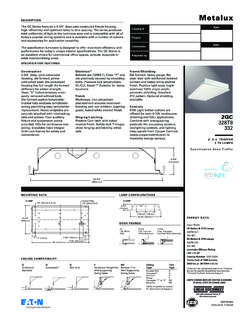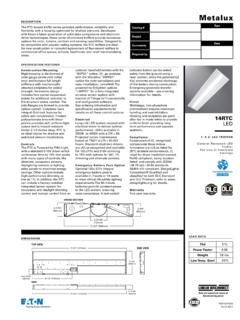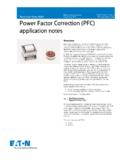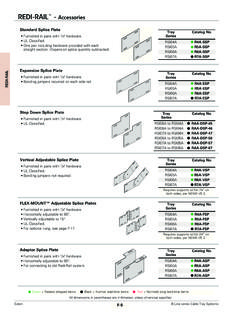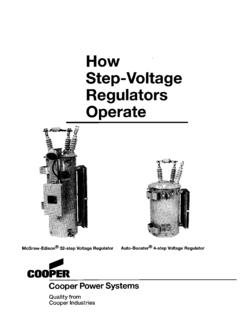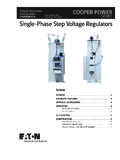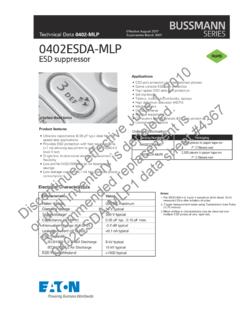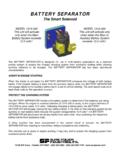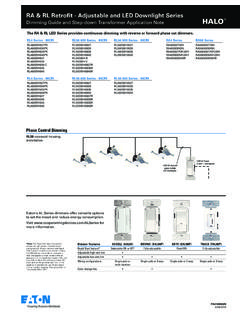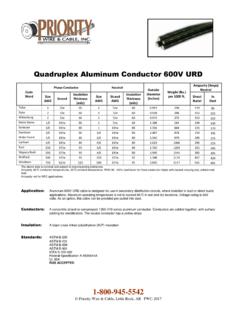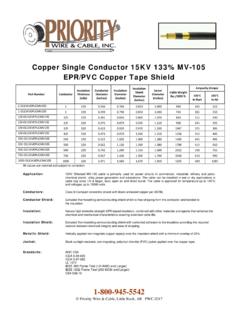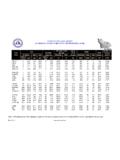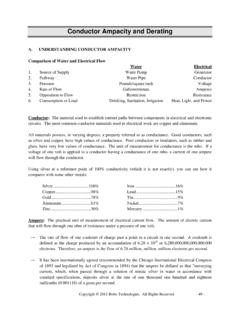Transcription of Conductors & Terminations - Cooper Industries
1 56 2005 Cooper BussmannConductors & TerminationsApplication Considerations4. The quick connect terminal is not seated properly. If the male-female connections arenot fully seated, a hot spot may be The quick connect terminal is being used beyond its amp rating. Quick connects typically have limited continuous current ratings that must not be exceeded. Typicalmaximum ratings possible for a quick connect are 16 or 20A (some are less); this isbased on a proper conductor size, too. If the quick connect is used beyond its amprating, excessive temperature will result which can degrade the quick connect s tension properties and further overheating issues The conductor is not properly soldered to a solder terminal. Again, if there is not agood connection between the two, a hot spot will be The terminal is only rated to accept one conductor , but multiple Conductors are beingused.
2 Again, the product specifications must be checked to see if the terminal israted for dual Conductors . If the product is not marked suitable for dual Conductors ,then only one conductor can be used for this termination . Inserting too many Conductors will cause a poor connection, which can result in heat or other important aspects in the electrical and thermal relationship for circuitcomponents in a circuit are the conductor size, conductor rated ampacity, theconductor insulation temperature rating and the permissible connector deviceconductor temperature limits. Conductors have specified maximum ampacitiesthat are based on many variables including the size of the conductor and itsinsulation temperature rating. The NEC establishes the allowable ampacity ofconductors for various variables and applications. In addition, there are someoverriding requirements in the NEC and product standards that dictate theampacity of Conductors when connected to terminals.
3 For instance, theampacity for a conductor with 90 C insulation is generally greater than theampacity of a conductor of the same size but with 60 C insulation. However,the greater ampacity of a conductor with 90 C insulation is not always permitted to be used due to limitations of the terminal temperature ratingand/or the requirements of the NEC . (Reference in the NEC for specific requirements.) However, there are some simple rules to follow for cir-cuits of 100A and less. These simple rules generally should be followedbecause these are the norms for the device component product standards andperformance evaluation to these standards for fuses, blocks, disconnects,holders, circuit breakers, rules for 100 amps and less:1. Use 60 C rated Conductors [ (C)(1)(a)(1)]. This assumes all Terminations arerated for 60 C rated Higher temperature rated Conductors can be used, but the ampacity of these Conductors must be as if they are 60 C rated Conductors .
4 In other words, even if a90 C conductor is used, it has to be rated for ampacity as if it were a 60 C conductor [ (C)(1)(a)(2)].For instance, assume an ampacity of 60A is needed in a circuit that has terminationsthat are rated for 60 C Conductors . If a 90 C conductor is to be used, what is theminimum conductor size required?Wire Size60 C Ampacity90 C Ampacity6 AWG55754 AWG7095 The answer is 4 AWG, 90 C conductor . A 6 AWG, 90 C conductor has an ampacityof 75 amps per (NEC Table ); but this ampacity can not be used for a 60 Ctermination. For this circuit, if a 90 C, 6 AWG conductor is evaluated, the ampacityof this conductor must be according to the 60 C conductor ampacity, which is are from NEC Table Conductors with higher temperature ratings can be used at their rated ampacities ifthe Terminations of the circuit devices are rated for the higher temperature rated con-ductor [ (C)(1)(a)(3)].
5 However, the industry norm is that most devices rated100A or less, such as blocks, disconnects and circuit breakers, have 60 C or 75 Crated For motors with design letters B, C or D, Conductors with insulation rating of 75 C ofhigher are permitted as long as the ampacity of the Conductors is not greater thanthe 75 C rating [ (C)(1)(a)(4)].5. If a conductor is run between two devices that have terminals rated at two differenttemperatures, the rules above must be observed that correlate to the terminal withthe lowest temperature circuits greater than 100A, use Conductors with at least a 75 C insulationrating at their 75 C ampacity why would anyone ever want to use a conductor with a 90 C or a 105 Crating if they can t be applied at their ampacity ratings for those temperatures?The answer lies in the fact that those higher ampacity ratings can be utilizedwhen derating due to ambient conditions or due to exceeding more than 3 current carrying Conductors in a (ampacity and derating tables next page)Circuit ampacity required: 60 ampsAmbient: 45 C 75 C terminal60 C terminalConductor size and insulation rating?
6 Assume that an ampacity of 60A is needed in a circuit with a 75 C terminationat one end and a 60 C termination at the other end, where the ambient is45 C. First, since one termination temperature rating is higher than the other,the lowest one must be used, which is 60 C. The first choice might be a 4 AWG TW conductor with an ampacity of 70A at 60 C. However, in the NEC the Correction Factors table at the bottom of conductor ampacity Table that the 70A ampacity must be derated, due to the 45 C ambient, by afactor of This yields a new ampacity of , which is less than therequired 60. This is where a conductor with a higher temperature ratingbecomes useful. A 4 AWG THHN conductor has a 90 C ampacity of , looking at the table at the bottom of Table , a factor of .87 mustbe used, due to the 45 C ambient. This yields a new ampacity of , whichis adequate for the required 60A a 6 AWG THHN conductor be used in this application?
7 Its 90 C ampacity is 75A. Using the factor of for the 45 C ambient gives a newampacity of , which seems adequate for a required ampacity of , a 6 AWG conductor of any insulation rating could never be used inthis application because the 60 C terminal requires that the smallest amountof copper is a 4 AWG for a 60A ampacity (simple rule 2 in previous paragraphs). The amount of copper associated with a 4 AWG conductor isrequired to bleed the right amount of heat away from the terminal. The use ofless copper won t bleed enough heat away, and therefore overheating problems could 2005 Cooper BussmannConductors & TerminationsApplication ConsiderationsAllowable AmpacitiesThe table below shows the allowable ampacities of insulated copper Conductors rated 0 through 2000 volts, 60 C through 90 C, not more thanthree current-carrying Conductors in a raceway, cable, or earth (directlyburied), based on ambient of 30 C (86 F) (data taken from NEC ).
8 The note for 14, 12, and 10 AWG Conductors is a very important notethat limits the protection of these For Temperature RatedSize AWGC opper Conductors (NEC Table )60 C75 C90 C14*20*20*25*12*25*25*30*10*30*35*40*840 50 55655 65 75470 85 953851001102951151301110130150 AmbientFor ambient other than 30 C, multiply conductor allowable AmbientTemp. Campacities by factors below (NEC Table )Temp. F60 C75 C90 *See NEC (D) which essentially limits (with several exceptions) theovercurrent protection of copper Conductors to the following ratings after anycorrection factors have been applied for ambient temperature or number ofconductors: 14 AWG - 15A, 12 AWG - 20A, 10 AWG - 30A. Depending on thecircumstances of a specific application, the ampacity determined due to thecorrection factors may be less than the values in Table In those cases,the lower value is the ampacity that must be observed.
9 For instance, a 75 C,10 AWG in 50 C ambient would have a derating factor of , which results inan ampacity of (35A x ). So in this case, the ampacity would Since is not a standard size fuse per NEC , NEC (B) would allow the next standard fuse, which is a 30A fuse. The 30 Afuse is in compliance with (D). In a 35 C ambient, the correcting factorfor this same conductor is , so the new ampacity is (35A x ).However, a 35A fuse can not be utilized because NEC (D) limits theprotection to DeratingConductor allowable ampacities must be derated when in temperature ambient greater than 30 C. The correction factors for the conductor allowableampacities in NEC Table Ampacity Correction Factors For Ambient TemperaturesConduit Fill DeratingAlso, conductor ampacity must be derated when there are more than threecurrent-carrying Conductors in a raceway or cable per NEC (B)(2).
10 There are several exceptions; the derating factors are:# Of Current-% Values in NEC Ampacity to As Adjusted for ConductorsAmbient Temperature if Necessary4 6807 97010 205021 304531 404041 & greater35 termination RatingsAs discussed above, Terminations have a temperature rating that must beobserved and this has implications on permissible conductor temperature rating and ampacity. Shown below are three common termination ratings andthe rules. Remember, from the example above, the conductor ampacity mayalso have to be derated due to ambient, conduit fill or other CCan use 60 C, 75 C, 90 C or higher temperaturerated conductor , but the ampacity of the conductormust be based as if conductor is rated 60 CCan use 75 C, 90 C or higher temperature ratedconductor, but the ampacity of the conductor must bebased as if conductor is rated 75 C. A 60 C conductor not permitted to be C/75 CDual temperature rated termination .
